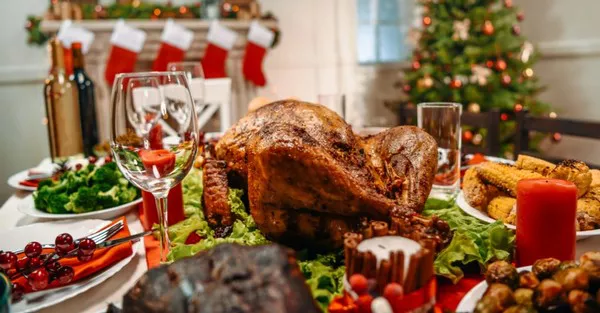Christmas is a time of joy, celebration, and indulgence, and one of the highlights of the holiday season is the delectable array of food. From traditional favorites to regional specialties, Christmas feasts vary across cultures and households. In this comprehensive article, we embark on a culinary journey to explore the diverse and mouthwatering dishes enjoyed during the festive season. Join us as we uncover the traditional and contemporary fare that graces the Christmas table, offering insights into beloved recipes, regional variations, and the significance of these culinary delights.
Traditional Christmas Staples
a. Roast Turkey: Roast turkey is an iconic centerpiece of many Christmas feasts. It is typically seasoned, stuffed, and roasted to perfection, delivering juicy and tender meat.
b. Glazed Ham: Glazed ham, adorned with a sticky, flavorful glaze made from ingredients such as honey, mustard, or brown sugar, is a popular choice for Christmas meals in many countries.
c. Stuffing: Whether it’s made with breadcrumbs, herbs, vegetables, or sausage, stuffing is a beloved side dish that adds depth of flavor and complements the main course.
d. Gravy: Rich, savory gravy made from the pan drippings of the roasted meat is an essential accompaniment that brings all the flavors together.
e. Mashed Potatoes: Creamy, buttery mashed potatoes provide a comforting and hearty side dish that pairs well with roasted meats.
f. Cranberry Sauce: Tangy and slightly sweet cranberry sauce, made from fresh or dried cranberries, adds a burst of color and a delightful contrast to the savory dishes.
g. Brussels Sprouts: Roasted or sautéed Brussels sprouts, often caramelized with bacon or tossed with balsamic glaze, offer a vibrant and nutritious addition to the Christmas spread.
h. Roasted Vegetables: A medley of roasted vegetables, including carrots, parsnips, onions, and winter squash, showcases the bounty of the season and adds vibrant flavors to the meal.
i. Yorkshire Puddings: A classic British addition to the feast, Yorkshire puddings are light, crispy pastries traditionally served with roast beef.
Regional Christmas Delights
a. United States: In the United States, regional variations come to the fore during Christmas. Southern states may feature cornbread stuffing, collard greens, and sweet potato pie, while New England showcases seafood dishes such as clam chowder and baked stuffed lobster.
b. Italy: Italian Christmas feasts often include dishes such as panettone (a sweet bread studded with dried fruits), tortellini in brodo (pasta in broth), and the classic dessert panforte (a dense, fruit and nut cake).
c. Mexico: In Mexico, Christmas celebrations feature tamales (steamed corn dough filled with various fillings), bacalao (salted cod), and ponche (a warm fruit punch flavored with cinnamon and spices).
d. Scandinavia: Scandinavian countries embrace their culinary heritage during Christmas with dishes like lutefisk (preserved cod), gravlax (cured salmon), and Jansson’s temptation (a creamy potato and anchovy casserole).
e. Australia: In the Southern Hemisphere, Christmas falls during the summer, inspiring outdoor barbecues and seafood-centric feasts. Prawns, oysters, and pavlova (a meringue-based dessert topped with fruit and cream) are popular choices.
Sweet Treats and Desserts
a. Christmas Pudding: A dense, moist fruitcake laced with spices and often soaked in brandy, Christmas pudding is a traditional British dessert served with a dollop of creamy custard or brandy butter.
b. Gingerbread: Gingerbread cookies, houses, or cakes are beloved festive treats, often intricately decorated and enjoyed by both children and adults.
c. Yule Log: The Yule log, or Bûche de Noël, is a festive dessert made of rolled sponge cake filled with cream or ganache, frosted with chocolate buttercream, and decorated to resemble a log.
d. Fruitcake: Fruitcake, soaked in alcohol and packed with dried fruits and nuts, is a time-honored Christmas confection that is often passed down through generations.
e. Mince Pies: Mince pies, small pastry tarts filled with a sweet mixture of dried fruits, spices, and sometimes a splash of brandy, are a traditional Christmas treat in the UK.
f. Marzipan and Nougat: Almond-based marzipan and nougat candies, often shaped into fruits or figures, are popular Christmas sweets in many European countries.
Modern and Contemporary Twists
a. Fusion Flavors: In today’s multicultural culinary landscape, many households embrace fusion flavors and incorporate global influences into their Christmas meals. From Asian-inspired dishes to Mediterranean-infused flavors, the possibilities are endless.
b. Vegetarian and Vegan Options: With the rise of plant-based diets, vegetarian and vegan Christmas feasts have gained popularity. Roasted vegetable Wellington, nut roasts, and plant-based gravies offer delicious alternatives to traditional meat-based dishes.
c. Gluten-Free and Allergen-Free Alternatives: Many households now cater to dietary restrictions and allergies by offering gluten-free versions of traditional favorites or allergen-free alternatives, ensuring everyone can enjoy a festive meal.
The Spirit of Sharing and Togetherness
Christmas is not just about the food; it’s about the joy of sharing and coming together with loved ones. Whether enjoying a grand feast or a simple gathering, the act of sharing a meal nurtures bonds, creates cherished memories, and celebrates the spirit of the season.
Conclusion
The Christmas feast is a time-honored tradition that showcases the diversity and richness of culinary delights across cultures and regions. From the traditional roast turkey and stuffing to regional specialties and contemporary twists, the festive table is an expression of love, generosity, and celebration. As you gather with family and friends, may your Christmas meal be a delightful tapestry of flavors, textures, and cultural influences, reflecting the warmth and joy of the holiday season.

